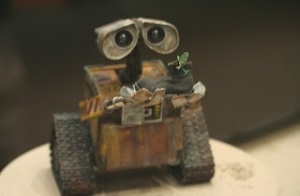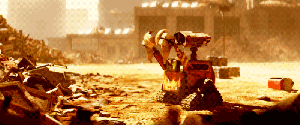 Using tried and true techniques that the company has mastered in the past decade, Pixar creates cute, comic movie characters to access serious themes that relate to the real world. Marlin the clownfish displayed the trials of single parenthood, Woody and Buzz witnessed the painful process of growing up, and, most recently, Merida must navigate the volatile nature of mother-daughter relationships.
Using tried and true techniques that the company has mastered in the past decade, Pixar creates cute, comic movie characters to access serious themes that relate to the real world. Marlin the clownfish displayed the trials of single parenthood, Woody and Buzz witnessed the painful process of growing up, and, most recently, Merida must navigate the volatile nature of mother-daughter relationships.
In Wall-E, Pixar raises environmentalist awareness with a particularly sympathetic main character, and – in my opinion – the most adorable robot since R2-D2.
 This robot captures audiences with his big sad eyes, yes, but also with his tender reverence for old times. His past, however, is our present. WALL-E, to paraphrase John Green, imagines the future with a kind of nostalgia by presenting a futuristic reality that keeps glancing longingly at its much greener past.
This robot captures audiences with his big sad eyes, yes, but also with his tender reverence for old times. His past, however, is our present. WALL-E, to paraphrase John Green, imagines the future with a kind of nostalgia by presenting a futuristic reality that keeps glancing longingly at its much greener past.
Set in the year 2805, earth has become one ginormous landfill, so cluttered and polluted that it cannot sustain organic life anymore. It is every environmentalist's worst nightmare. In an obvious critique on consumerism, humanity has literally used up all of its resources and leaves earth to fend for itself.

Only the main character, WALL-E, inhabits Earth. He also has the impossible task of cleaning it up all by himself. Throughout the film flashed the massage "WALL-E: works to dig you out." His job is to maintain what is left of earth by sifting through its piles of trash. Due to centuries of neglect, all of WALL-E’s fellow janitorial-robots have perished, leaving him with only a cockroach for company as he works to clear humanity's mess.
The most stunning aspect of this near-apocalyptic world is the blatant waste. Technically speaking, WALL-E focuses on land pollution, or the contamination of the earth’s surface level by dumping waste and misusing soil; the kind of pollution only people can cause. WALL-E’s incredibly detailed animation shows a brown, desolate Earth with a skyline of compressed trash and a mountain of loose litter.
Clearly, pollution is the real antagonist of the film.
Fortunately, the earth couldn't ask for a better steward. WALL-E has a knack for fixing the broken and nurturing the weak. So it is only appropriate the WALL-E is the one to find earth’s first sign of life in decades, a fragile new plant sprouting among the waste piles.
This one plant comes to represent humanity's last hope to connect to their natural roots.
The human race, having abandoned the dirty Earth to live in a space-cruise ship, has grown animalistic due to its separation from nature. Lazy, gluttonous, and entirely dependent on technology, this “advanced” society seems less human than the robotic force it depends on. WALL-E, in comparison, seems that much more sensitive to the needs of others, including the earth.
The beauty of this robot lies in his compassion and resourcefulness. WALL-E never disposes what he can save and reuse. He stays functioning by scavenging parts from other broken down robots, and his home is full of trinkets he has saved and repaired.
Despite his technological nature,WALL-E has often been compared to early human figures like Adam and Prometheus – great classical men striving to make the earth a good home for humanity. Though he is no Batman, WALL-E truly stands up to Pixar's most noble heroes.
Tell us your thoughts about WALL-E: is it a warning of what might come to pass, or mere science-fiction fun?







